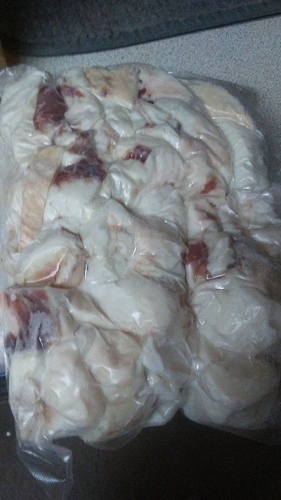What are Tallow & Suet?
Tallow is the finished product of rendered beef (or lamb) fat. It is a solid at room temperature and will keep for months when in a sealed container. Suet is the type of fat that tallow is made from – it comes from around the kidneys and loins of the animal, and can be quite hard and dry. Rendering involves melting the fat down slowly and clarifying it – removing any impurities, such as bits of meat attached to the fat and also any moisture. Removing the moisture and impurities will ensure a longer shelf life of the tallow.
You may have heard of lard – this is the equivalent product to tallow, but is produced from a pig.
But why would I want to choose tallow to cook with?
Factors to consider when choosing an oil or fat to cook with
There are 4 things that come to my mind when I consider if a fat or oil is healthy or not and whether I should cook with it?
Is it Polyunsaturated?
I want to know if an oil is polyunsaturated, because if it is, I don’t want to choose it. Saturated fats like tallow and butter are protective of our bodies – they help us to minimise any stress in the body. Polyunsaturated oils however, can amplify the stress response and have been linked to cancer, heart disease, premature aging and more. I have written more detail of this elsewhere. (Scroll down to ‘Choose Saturated Fat’). Soy oil, cotton seed oil and sunflower oil are examples of polyunsaturated oils. Increasingly, more people are waking up, doing their own research and making conscious decisions for their health by choosing saturated fats.
Omega-6:Omega-3 ratio
The Omega-6:Omega-3 ratio of a fat or oil is important to me because an undesirable ratio can be detrimental to health. Sally Fallon (who’s cookbook and associated health writings I love to read) refers to research that has shown excess Omega-6 intake in the diet results in an increase in tendency to form blood clots, inflammation, high blood pressure, irritation of the digestive tract, depressed immunity, cancer and weight gain. My understanding is that it is the ratio of the two that is important more than the Omega-6’s being bad per se.
The challenge with average modern day diets is that they contain a high proportion of Omega-6’s both in many of the oils available for us to cook with and especially in processed foods. I’m referring to many of the plant based oils like sunflower, canola, cottonseed, peanut and soybean oil -predominantly the polyunsaturated oils. These are the cheapest of oils and thus the ones of choice in most processed foods.
Compounding the challenge to intake an appropriate balance of fats in today’s society is the influence of some modern farming practices on the health of the finished product. Research shows that not allowing animals access to grass pastures, but rather grain feeding alters the Omega-6 to Omega-3 ratio of the animal products to an undesirable ratio. Specifically, 16:1 in grain fed tallow versus 1.4:1 in grass fed tallow, in this particular research.
Note that the ratio of Omega-6 fatty acids is not quite as simple as I indicate above. Linoleic acid and arachidonic acid are two Omega-6 fatty acids which are believed to increase inflammation not considered healthy when consumed in proportionately high levels. There is however an Omega-6 fatty acid that is beneficial and actually anti-inflammatory. This is GLA or Gamma Linolenic Acid, but it is found in obscure oils such as evening primrose oil or black current seed oil, so not really relevant in this discussion.
Has it been processed?
I also like to consider if the fat or oil is in its naturally occurring state. Trans fatty acids are reported to be especially harmful to health. These fats come from hydrogenated vegetable oils via a chemical process, to form artificial trans fatty acids. The hydrogenation means that what were liquid vegetable oils (like soy, canola, sunflower) become solid/semi-solid at room temperature. Margarine is one such example. These are the fats that have had the worst press regarding their impacts on health. They have been linked to heart problems & cancer amongst other things, and you can easily search online to learn more about trans fatty acids. …More

